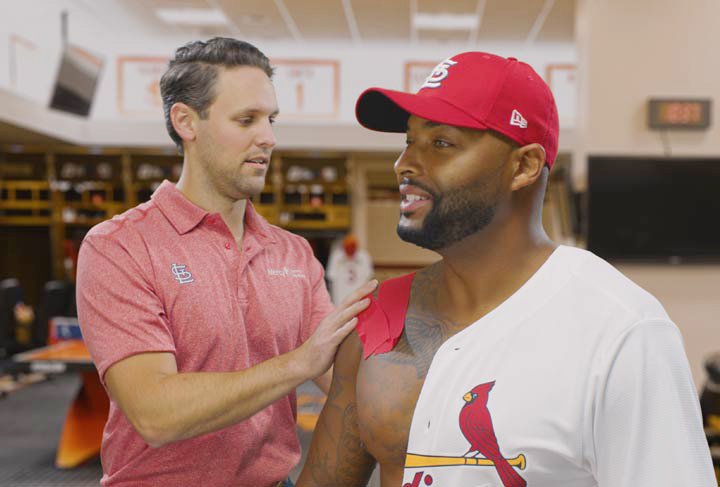
“When Can I Throw a Curveball?”
- Home
- Services
- Service Lines
- Sports Medicine
- “When Can I Throw a Curveball?”
By Brian Mahaffey, MD
At Mercy Sports Medicine, we prefer to prevent injuries instead of treating them. In youth baseball, most arm injuries can be prevented with athletes, parents and coaches following simple rules.
There is a simple truth in medicine: “Children are not young adults. ” Children prior to puberty can potentially injure growth plates in bones. Growth plates are like “Oreo cookies. ” The soft, cream filling is the growth plate and the cookies are the bone. You can break it or slowly pull it apart, and the “cookie” is not the same afterwards. Specifically, the growth plate is 2 to 5 times weaker than the adjacent tissue. This leads to bone injuries in children that would be “strains and sprains” in adults.
With youth throwers, especially pitchers, one specific growth plate is of concern: the inside of the elbow. This growth plate is very susceptible to injury from repetitive stress.
In pitchers ages 9-14, 50 percent report elbow or shoulder pain during their baseball season. The elbow is the most common pain source. Most of the time, these young athletes either ignore this pain or coaches and parents feel it is “normal. ” If the discomfort is still there the next morning, it could be a warning sign of potential issues.
The most common issue is “Little League Elbow. ” This injury can range from mild irritation of the growth plate to a displaced growth plate fracture. Usually, patients present with inside elbow pain, a decreased ability to throw and decreased throwing distance. If a “pop” was noted, we become very concerned for a true fracture. These injuries need to be treated very conservatively by an expert to prevent long-term issues. If patients do not recover well, we see a dramatically increased chance of a throwing athlete to have long-term issues.
As this growth plate closes, we become very concerned with injuries to the Ulnar Collateral Ligament (UCL), often referred to as the “Tommy John” ligament. These teenagers present very similar to “Little League Elbow. ” Nationally, we have seen a dramatic increase in these injuries at the high school level. Most of these athletes report a year-round throwing program. These should be treated conservatively with a partial tear, but surgery is usually needed for a complete tear to return to throwing competitively.
How can these injuries be prevented? The best way is to prevent repetitive stress on the elbow. Limiting the number of competitive pitches to 75 a week and 600 per season as well as having a three-month rest period from throwing has been shown to help. Playing in only one league can be protective as well. Any type of breaking pitch, except a change-up, greatly increases the risk of injury. Throwing change-ups can actually decrease the risk of elbow injury in youth throwers. Essentially, we tell throwers that they should not throw any breaking pitches until they start shaving, usually around age 14. Also, maintaining good stability, strength and conditioning as well as learning proper throwing biomechanics will help lower the risk.
These throwing injuries can be prevented if youth throwers, parents and coaches educate themselves and follow these simple rules. By doing this, we at Mercy Sports Medicine feel young athletes can develop their talent appropriately, enjoy activity and minimize their risk of injury.
Dr. Mahaffey, MD, MSPH, FAAFP, is director of Mercy Sports Medicine and a team physician with the St. Louis Cardinals.
You can reach Dr. Mahaffey at 636-893-1360.
Related Articles
Athletes who return to play or practice before fully recovering from a concussion are at higher risk of sustaining another concussion.
Read MoreHard work and eating right are the keys to athletic success and good health.
Learn MoreNo matter how severe your knee arthritis is, staying active is the best treatment.
Read More